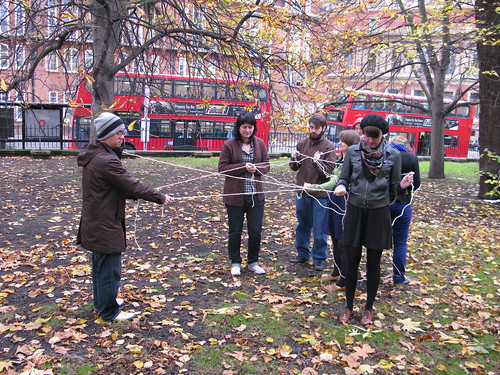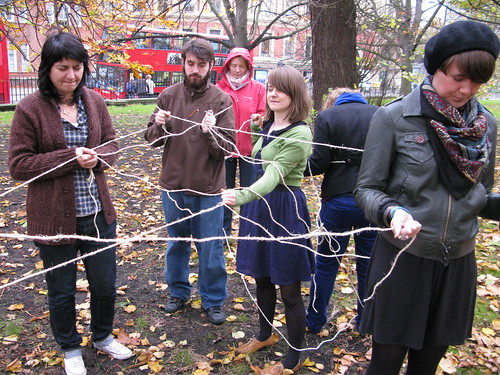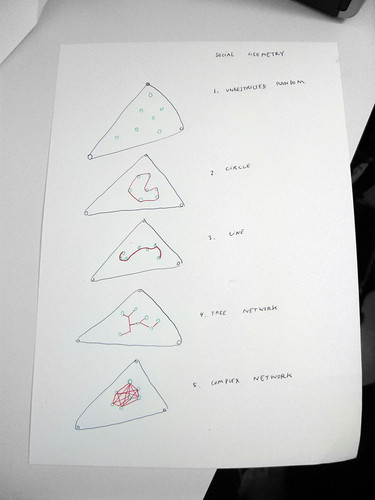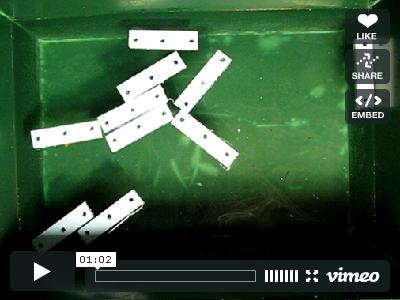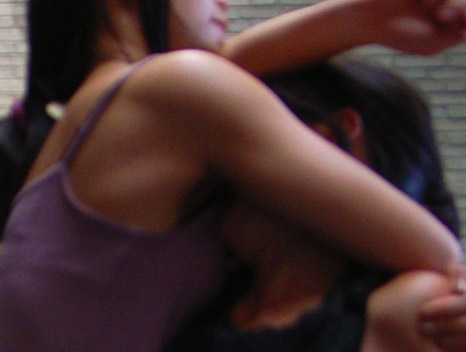
some feedback on the last showing:
(i think many of these points i may have already touched upon with you just after, but immediately post-performance it’s probably difficult to digest, so here again)
- – it seemed a lot more ‘performed’ this time compared to when Mon and I first joined the rehearsal. i missed the awkwardness of the “goofy-ness”, the unintended collisions… now it became more slick, more purposeful. on one hand, this made it less interesting for me, but thinking again, as Yijing pointed out, that we have to consider the final context that this will be performed in, which is a much less literally staged space. Thus we should consider, > performativity of the space leads to < awareness of the performativity of the performers? You are right that “noticing” is much more difficult when not on stage, when we are specifically asked to “watch”. Thus, building up the strong structuring of the movements may be necessary to break it down again in different contexts, with less control of the relation between audience and performer.
- – fenghai’s wobbly head…
- – the ending. on one hand, the awkwardness of not knowing if the performance is over or not is a great element to play with. but i guess given the formality of the last showing, with audience lined up properly around, it made it very uncomfortable. you feel very much an voyeur, seeing this vulnerable moment of the performers, intertwined and laughing amidst themselves. this again is something that i think will work much better in our final space, as i said, because we can understand as viewers this idea of “interrupting someone in their house”, versus “interrupting a performance”. seeing all of you raw like that in the end is something similar to what i said about making a situation where the viewers enter a darkened space only to find all the performers there, sitting together watching television. i like the idea that you expect to view something, and instead you view others viewing something else. this is a kind of uncanny. should we watch them watching tv, or should we watch what’s on tv?
- – moving the “distortion” section to the middle of the piece was nice. I think it worked well. i didn’t tell you before, but when i saw this section before, immediately thought of the paintings of francis bacon, which you should really check out if you can. it spoke a lot of the issue of identity for me, which was good in the wake of all this question of collectivity.
- – but regarding the progression from individual to collectivity, i am wondering why most of your ‘encounters with the other’ are based upon conflict, antagonism. this is the feeling that comes out of these accidents and the locking, and i would like to explore more what possibilities we would have to “collect” together on the basis of something more harmonious, something more “together”. what do you think? i think this is what you were getting at with the end of the piece, but why does this suddenly spring out of exhaustion? could we have not grown exhausted together, rather than out of going against one another?
today, a close one (bangba)
taijiquan with Jiang Jun in the morning, saying hello, coming closer and closer, rehearsal in the 村, 曲哥 eats lunch with us (!), emotions rile, “no, didn’t feel like kissing”, “and what if we could operate rationally”, better to add one man than risk a cat fight. Acknowledgement, open meeting, accidents, fake falling, genuine falling, locked in embrace but moving forward with a direction.
[image taken from press release of Voice Over – on staging, activism and performative strategies in contemporary art practices, published by Sternberg Press in conjunction with Iaspis, to be launched during the 2009 Venice Biennial]
Posted by e | reply »Social geometry, relative positionning, Dingpolitiks
I would like to talk about 4 experimental setting in social geometry. Chess. Social geometry. Floating bits. Swarm Operating system.
————————————-
Chess.

In the game of chess there is this incredible tension that is always here. Every piece contains a potential for movement, static objects suggests vectors of movements, radius of action, patterns of movement. It is politics as much as it is cannibalism, or the pretty dance of death.
————————————-
Social Geometry.
I made this experiment, I called “social geometry” :
0. Settings
Make the people stand up, encircle a wide are around them with a rope without touching them. Big enough to move, potentially small enough to make them collide often.
1. Unrestricted random :
Ask them to close their eyes.
Spin on themselves until they’ve lost original orientation and relative positioning of other participants.
Ask them to walk eyes closed in random direction.
Ask to stop, stand still with eyes closed and imagine a mental map of their position in the shape and other participants positions.
Ask to open their eyes, compare their blind mental map and the reality.
2. Circle :
Walk around them with a rope, create a circle the participant hold onto on the outerskirt. Ask people inside the circle to come at the edge.
Ask them to walk eyes closed in random direction. (same)
Ask someone “take the lead”, someone (maybe several people) Simultaneously auto-elect themselves and pull the group in a direction they decided.
Ask to stop, stand still with eyes closed and imagine a mental map of their position in the shape and other participants positions. (same)
Ask to open their eyes, compare their blind mental map and the reality. (same)
3. Line :
Cut the rope, open the circle, it becomes a line.
Then, eyes closed; walk in random position; someone (several people) take the lead; stop; mental map; eyes open; compare mental map and reality.
4. Tree network :
Cut the rope in small pieces, add many small branches, create a simple tree network.
Then, eyes closed; walk in random position; someone (several people) take the lead; stop; mental map; eyes open; compare mental map and reality.
5. Complex network :
Add many many conexions between them, create complex newroks, each participant should have at least 4 threads to hold, leave some conexion loose, some conexion under tension.
Then, eyes closed; walk in random position; someone (several people) take the lead; stop; mental map; eyes open; compare mental map and reality.
Observations, report :
Random may not be the right term because behavioral pattern emerge in each experiments. Or organization quickly emerges.
1. Unrestricted random : participants are new to the experiment, they fear collision and focus on avoiding them. Participants quickly have different attitudes : hands spread ahead as antennas, or just giving up security and walking hands in their pockets.
2. Circle : The shape is shifting position smoothly, when I ask someone to take the lead, the harmony is suddenly broken. Dynamic shape, easy to read and people are moving fast.
3. Line : The line often turns into a “S” and when people are touching, the “S” inverts. The movement is very disorganised unless the one taking the lead is at one extremity. People at the extremity are unlikely to take the lead since they are the less connected.
4. Tree network : Quite stable shape, the overall population remains in the same comfortable area and spread, very little overall movement. Acurate mental map thanks to the tensions in the network. Many people take leadership at the same time and create disorganised movements.
5. Complex network : Interelational links getting tighter, static geometry, very efficient at moving as it is a compact “organism”, when someone takes a clear leadership.
Single individual have a strong movement and involvment signature, but the quality of the connexion make patterns of behavior emerge : the type of connexion creates a dynamic pattern. The duration of each experiment is crucial (here each 4 minutes) and confidence builds up : ultimately the structure becomes more dynamic, moves more quickly, as if moving together in a single direction was a collective target synonim with efficiency.
Within the group, the person who takes the leadership is well negociated : people auto-regulate and people who take leadership are changing at every experiments.
2 individual profile emerge : static spreader | dynamic leader : some people like to spread out in space and relax | some people like to interact with other and create shapes, complex dynamic emerge, one overall shape has active and passive points…
————————————-
Floating bits.
I wanted to know what happen when passive bodies interact ; in opposition to active bodies (humans). Passive bodies interact with “invisible forces”, surface tension, get closer with capillary action, fluid viscosity. Human are so much more complicated than floating bits, yet floating bits and the physics behind it, and the “insible forces” (do you know dark energy?) are so interesting to study and be inspired from. Imagine a chess game the size of the universe… where everything works according to unknown forces, completely different than gravity…
————————————-
Swarm Operating system.
There are attractors – actors (yellow moving dots) want to get close to / there are repellant – actor want to get away from / you can adjust the level of “collaboration” or proximity between actors, basically the density of a group.
The idea is to create politics assisted by computer, an object oriented politic (concept of “dingpolitiks” Bruno Latour, “Making Things Public“, MIT press 2005).
With Hiromi Ozaki on http://hi-ve.net we tried to re-create a little bit of the complexity of human behaviour and optimize it on real scientifical datas, with highly customizable individual variables. Actors automatically create “groups of interest” and keep on interacting within those in dynamic movement patterns.
————————————-
With dance, how can we take such thinking further?
Posted by cesar | more »World Record in Japan: Largest Orgy
Japan has successfully set a new world record. Having 250 men and 250 women who commenced to have sex in the same place at the same time, completing the world biggest orgy ever!
The Orgy was held in a warehouse with a professional camera crew taking pictures and recording the entire event, which was pretty hot and sticky.

Imagine what it must be like to come stumbling across a room filled with 500 people having oral sex and screwing their brains out. Not to bad a way to end your day huh?

It all seemed a little too organized for our personally liking but leave it to the Japanese to accomplish a goal. Especially if it had anything to do with naked women and sex.


The entire event was actually filmed and available for purchase on DVD for around $40. Here is a picture of the cover:
source: http://www.weirdasianews.com/2006/10/13/world-record-in-japan-largest-orgy/
Posted by mon | more »eat, walk, talk, thoughts, ideas, excercice, question, answer
i feel part of the process of finding the connection between us is come closer and get deeper in our own project, being curious about the others work, following the process of the others and knowing how this will relate to a end product, spending time together, trying to understand eachother…
question to monika:
– how does the video material relates to the 2 performers?
– is it (let’s say there is 5 interviewees and 2 performers in space) 7 people in space or the one performer representing the 5 people or more talking in general about people?
– how much is this 1 to 1 working method going to reflect in the work?
– how are these intimate information of the interviewees going to be used and how much is it exposed to a public or the people working in the project?
– what do you hope to hear from the people you are interviewing and where do you want to lead them?
questions to elaine:
– how do you imagine to organize the cooking workshop?
– how does the video relates to the sculpture and the performance aspect of your work?
– what kind of food is there going to be?
– how shall we visualize the perfomative moment of your work?
– how long does the video takes that is played in loop?
– how big is the screening?
– are screening and sculpture in the same room?
general question for all of us:
– how does the thing hold together?
– how do we conduct the audience?
– what is the development of the event? working towards climax, deconstruction, succession of scenes without any developement,…?
– what is the athmosphere that you want to lead? is there any negative energy developing?
– what is your personal conern as an artist?
– how do you relate to the other two artists?
– what is our intention?
– who is the audience?
– how do we want to integrate the people from the neighborhood into our work?
– and how do we want to integrate the experience of living and working together as a community in a courtyard in the product?
– what’s a total experience?
all these are questions, that we have tried to answer. i didn’t want to give the answers of the people, leaving up to them where they are in the process of finding them. you can add if there is any other question that would come up or i forgot and please feel free to ask me as well? i try my best.
Posted by sim | reply »5 months ago…
中国本地的女性
采访话题:性的喻义
1. 我身体的关系、权利、欲望与恐惧:这些采访是以身份为主题的研究的一部分。这个采访与“性别认同”有关,并考察“性别认同”究竟由自己决定还是仍然受社会习俗的定义约束。在大多数社会中,性这个话题通常被置于与道德和信仰有关的地位,并且通常被认为是一个禁忌话题。性交尤甚,虽然性交是人类的本性并且是人类社会传宗接代的必经之路。“我的身体只属于我自己!”人类对性的需求是非常个人化的,而且因人而异。我对自己的身体了解多少?我对自己的需求、欲望、恐惧和如何行使自己权利了解多少?是我自己的选择还是社会的选择?如果你让我从一个更广的角度来定义“性”这个概念,这便引出了关于自己身体以及如何通过我的身体来认识自己的问题。既然“性别”是每个人对于自己是男性或者女性、另一个性别或者没有性别的定义;这次采访的对象我清一色选择了女性,是因为我想看一下同样是女人,对性别的理解会有何不同。每个人都可以不根据自身的性别特征来确定她的性别。我想研究的是何种因素会导致“性别认同”的定义模糊,以及人们如何定义女性阴柔,男性阳刚和雌雄同体等概念。在当今的中国社会中,哪些社会因素影响着女性对于性以及他们自己身体的感悟。
2. 我自己身体同另外一个身体的关系,力量、感受、爱、恨、喜、悲、欢的互动:人们进行性交并不仅仅是人类生欲所需,它的另一个作用是社交,即帮助人们交换情感:例如喜爱和温柔。这也许会发生在恋爱阶段,体现双方相互依赖的关系,而同时也是一种力量的互动,还包括恐惧和憎恶的感觉。力量的互动需要至少一个性伴侣来完成,另一个可以个我产生反应的身体。什么是人与人之间的力量交换?我如何才能感知到其他身体?我的身体与其他身体有何不同?历史和社会因素造成关于性道德的分歧可以参考对于婚姻的理解(婚前性行为和通奸)以及婚姻/居住状态(一夫一妻制,多配偶制)。提及力量,卖淫、性暴力和乱伦是社会关注的焦点,同样这些肯定也会出现在这次采访中。而这次研究主要关注的是一个人自己的身体同其他身体所产生的互动,尤其是日常(性)生活中力量的转换问题。
Posted by mon | more »Courtyard versus Skyscraper

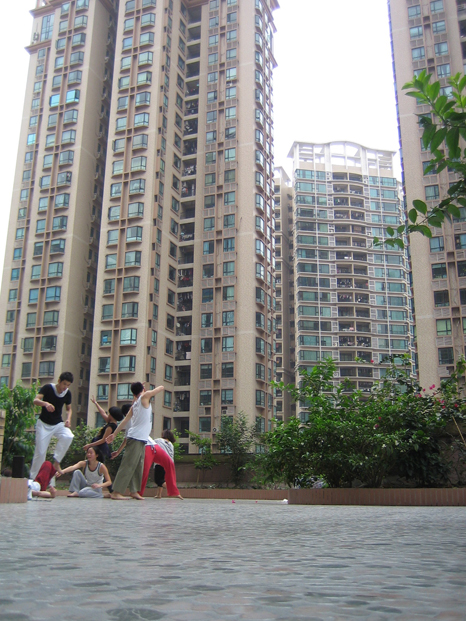
老太太约秀娥
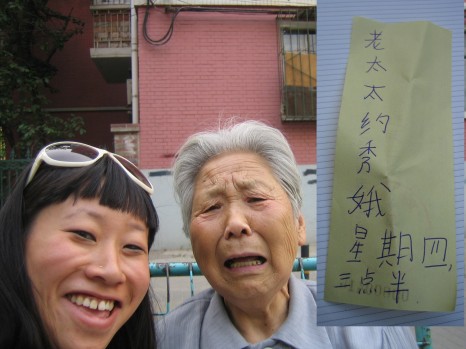
i was sitting on a bench at the intersection of 朝阳们外大街 and 东大桥. She looked at me and asked me if she can sit next to me. “I can tell you aren’t from here. You observe your surroundings. You look like you have time .“
I met 老太太 on Wednesday, May the 6th, for the first time. She is a happy nature and definitely very out going. I met her yesterday for the second time, as arranged at 4pm. She was half an hour too early. She doesn’t have a watch, but just asks people what time it is. She didn’t mind to wait for half an hour. She turns 84 this year and went 4 years ago for the first time in her life to School. She was going for 3 years every week 2X/Wk to English classes. She had to study Chinese and English at the same time, because she’s illiterate (文盲: I like the Chinese word for it. language blind.) Her Chinese has improved. She can read some daily-used characters, but can’t remember how to write them. And she can sing the English Alphabete!
What is an important bodypart of a woman?
She showed me her breasts. Actually only one, because she had breastcancer and had to remove her right breast. What stayed is a big scare. I was suprised how open she was.
We are sitting on a bench, she lifts her blouse and I gaze at her breast…
Posted by mon | more »the power of communication
Effective communication has always been a headache for me, since, sometimes it can be really hard to achieve. It is difficult among my compatriots, and it is even harder between two different civilizations. I must admit that communication is only effective when people are willing to talk, however, sometimes this alone dose not necessarily bring you to any point that is constructive. It’s sad and depressing that even there’s some mutual understanding, communication is still not promised.
A Chinese middle aged woman will hardly understand why you want to investigate in her sex life, neither will an office lady get why you want to do something for nothing…
I have no idea how each party could ever understand each other. But maybe, as long as you try to respect (not even understand) each other’s civilization, cultural charateristics and personality and to go beyond stereotypes, things may work?
May be.
Posted by sylvie | more »sounds intense, “we are in a strategic situation toward each other”
(i was not involved in what sounds like an intense discussion, so less personal for me; hope you don’t mind i bring it back online…a lot of it is focused upon the gay movements or s&m culture, but i think we can look at it from all our interests, whether that be power relations, sexual relations, or cultural identity formation…”Rather, we have to create a gay life. To become.”)
“Sex, Power, and the Politics of Identity“, an interview with Michel Foucault by B. Gallagher and A Wilson in Toronto in June 1982. [pdf, 216 kb]
Posted by e | reply »a little of switzerland or something in Vietnam
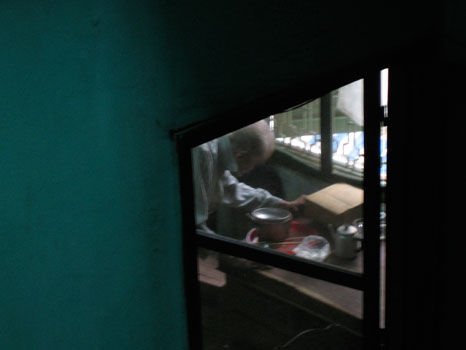
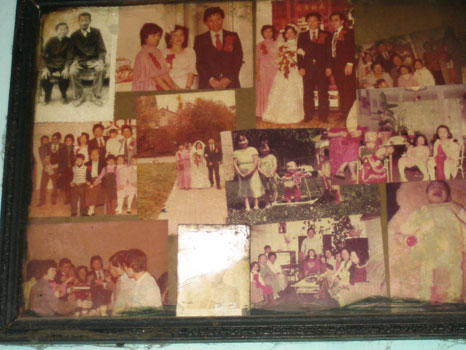
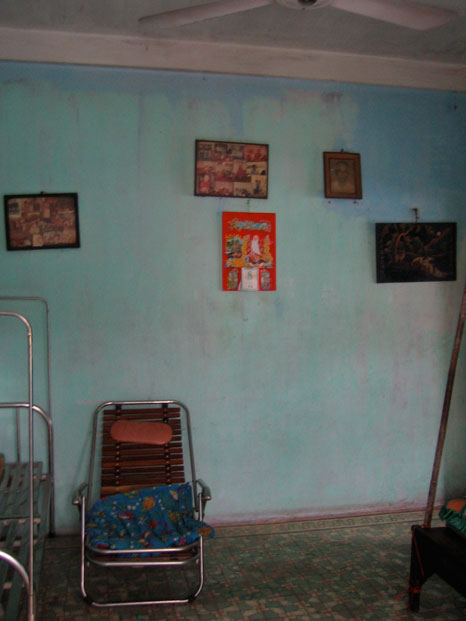
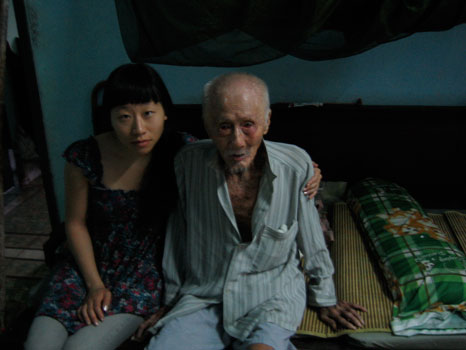
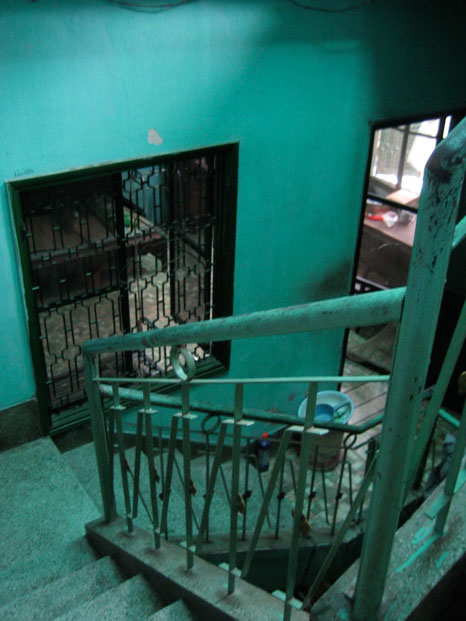
rejected
7th Asia-Europe Art Camp for Visual Arts 2009/2010 | Moved, Mutated and Disturbed Identities, Application 何穎雅 ELAINE W. HO
As a national of none of the ASEM member countries, my motivation to participate in the Asia-Europe foundation’s 2009/2010 Art Camp is a flailing attempt. But it is call to response, for while the jury panel may notice immediately my lack of proper qualification to join the project, I would like to question the very mutation of identity that we bear by our claims/rights to citizenship, and how—while we would like to imagine the fluidity of identity within networked society—it is exactly the restrictions that we remain bound to (by way of the financial system, funding of the arts, national/international concerns, the ‘guise of cultural exchange’) that show the futility of identity as such. Can there be such a thing as a moved, mutated or disturbed identity? Is not the very nature of the stamp of identity (at border control or at tax time) such that it fixes us, holds us responsible to the laws, rights and privileges of whichever particular one we may be so lucky (or unlucky) to have? Those of us who evade and escape such identity formations (the expatriate, the refugee, the trickster) shatter the very notions of identity that most people take for granted; they leave identity, create ambiguity and garner suspicion. And thus fluidity very easily finds itself blocked in the real world. We are the stateless, the draft dodgers, the cynics. The neither here nor there.
[text taken from the letter of motivation for the 7th Asia-Europe Art Camp for Visual Arts 2009/2010]
Dear Elaine:
Greetings from the Asia-Europe Foundation and Casino Luxembourg – Forum d’art contemporain.
We have received your application for the 7th Asia-Europe Art Camp-Art Workshop for Visual Arts 2009/2010. Thank you for your interest in the project.
The 7th Asia-Europe Art Camp-Art Workshop for Visual Arts 2009/2010, being organised by Casino Luxembourg, the University of Luxembourg and the Asia-Europe Foundation, is open to young visual artists from ASEM (Asia-Europe Meeting) countries. As you currently hold a US passport, we are unable to accept your application for the 7th Art Camp.
Currently, ASEM member countries include Austria, Belgium, Brunei, Bulgaria, Cambodia, P.R. of China, Cyprus, Czech Republic, Denmark, Estonia, Finland, France, Germany, Greece, Hungary, Indonesia, India, Ireland, Italy, Japan, South Korea, Laos, Latvia, Lithuania, Luxembourg, Malaysia, Mongolia, Malta, Myanmar, the Netherlands, Pakistan, Philippines, Poland, Portugal, Romania, Singapore, Slovakia, Slovenia, Spain, Sweden, Thailand, United Kingdom and Vietnam. Your country is not part of the ASEM process yet. Hence, we are presently unable to accept your application at present.
We, therefore, regret to inform you that you would not be eligible to apply for the 2009/2010 edition of the programme. However, if are interested in applying for the 2011 edition, please visit the website of Casino Luxembourg’s Art Workshop at www.ArtWorkshop.lu.
Best regards,
Anupama
There is only a You amidst all of this, and while paperwork may never allow us to get past it, shouldn’t that space between the You and the I be the most significant one?
Posted by e | reply »silence
it’s never silent. there are always some noises, always something to see, smell, taste, feel…
i see families living by 4 in one room of 10 m2. houses are open, everyone can look into it. babies are sleeping, people are watching television, drinking coffee, tea, people are watching, touching.
we share the same space, the same time, the same air, the same city…
do we share our body?
is our body the only thing that is private?
what happens if we make our body public?
‘aesthetics of silence‘ by susan sontag (read by paul chan)
Posted by sim | reply »there is a story behind this image
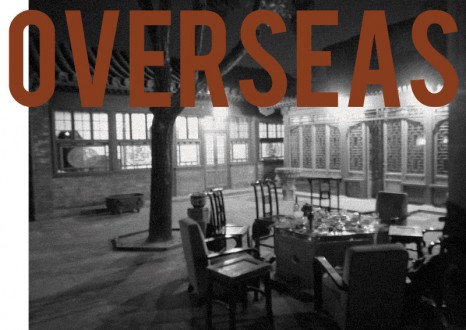
he was so drunk when we arrived, had to touch fingers to the glass table top to keep standing up, his 黄酒 spilling to the sides, splashing on the glass, sparkling in the frays of his braided goatee. they were laughing at him, i think they were laughing at him. constant repetition, “祖国就是悲剧”, “祖国就是悲剧” and “好东西“。And what about this? and this? They were making fun. End of the night silences. Another grunt, he doesn’t give a fuck. He has 好东西! The motherland is simply a tragedy! We follow, think, repeat. Off to bed. and he’s still leading our way.
concepts to discuss
these are at the moment the main concepts my work is going to turn around. I met up with Xiao Ke today, we talked about that. It’s still to be developped, discussed, experienced and shared. So each of us is going to think about it and bring suggestions to make it physical, create methods, give exercises, make scenes… please feel free to join and comment!
1. pass ways, shifting timing, faith, coincidence, accidents: we move in the given structures, outer logical structure, for example streets in a city.
2. moving organsime (bacteries, animals in the nature…) related to biology, phisics and chemistry: inner logical structure
3. meeting in different scales: small (intimate meeting), medium (a meeting of a few people), big (a demonstration, a battle). the impact a meeting has on a person and the space around it.
4. energy versus qi, chinese philosophy, understanding of space (cultural differences)
5. power: what is power? what does power mean to you? and how does power relates between human being, space and time?
6. public and private space: what is public and what is private?
7. net work: the need to create a network to gather. create, recognize and pull strings.
Posted by sim | reply »